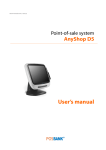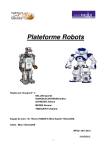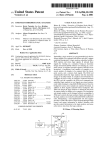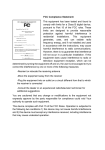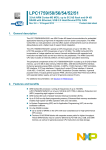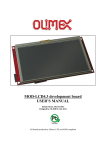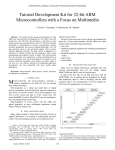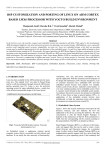Download Ethernet Implementation on Microcontroller
Transcript
International Journal of Electronics and Communication Engineering. ISSN 0974-2166 Volume 7, Number 2 (2014), pp. 99-104 © International Research Publication House http://www.irphouse.com Ethernet Implementation on Microcontroller Yasmeen.S1, Nagabhushan Katte2 and Anitha3 Department of Electronics and Communication Engineering, Ballari Institute of Technology & Management, Bellary–583104, VTU, Belgaum E-mail:[email protected], [email protected], 3 [email protected] Abstract Internet is becoming more widespread, there was the possibility of communication with automation systems for configuration, reprogramming or control in real time. For this, the automation system needs a physical communication port with the network. This paper presents the design and implementation of such Ethernet interface for automation system with microcontroller. The connection between the automation system and the interface is made via an SPIport. Keywords: Ethernet, Cortex-M3. 1. Introduction The Ethernet controlled devices has its own demand and application with fast development in technology. The system of data acquisition and control is designed based on the Cortex-M3 processor in the research activity. The proposed activity is designed to add security issue to any general premises. It realizes an embedded web server, which enables data acquisition and status monitoring with the help of any standard web browser. In this paper, device control and data acquisition system is based on embedded Ethernet platform support is designed. The processor has inbuilt Ethernet to optimizing the hardware complexity of the system. A data can be transmitted transparently through the internet it is built into cortex-m3 processor to the remote end desktop computer. This design has the advantage of low power consumption, cost-effective, easily realized, stable and reliable transmission. In today's business world, reliable and efficient access to information has become an important asset in the quest to achieve a competitive advantage. File cabinets and 100 Yasmeen.S et al mountains of papers have given way to computers that store and manage information electronically. Coworkers thousands of miles apart can share information instantaneously, just as hundreds of workers in a single location can simultaneously review research data maintained online. Computer networking technologies are the glue that binds these elements together. The public Internet allows businesses around the world to share information with each other and their customers. The global computer network known as the World Wide Web provides services that let consumers buy books, clothes, and even cars online, or auction those same items off when no longer needed. A LAN architecture developed by Xerox Corporation in cooperation with DEC and Intel . Ethernet uses a bus or star topology and supports data transfer rates of 10 Mbps. The Ethernet specification served as the basis for the IEEE 802.3 standard, which specifies the physical and lower software layers. Ethernet uses the CSMA/CD access method to handle simultaneous demands. It is one of the most widely implemented LAN standards. A newer version of Ethernet, called 100Base-T supports data transfer rates of 100 Mbps. And the newest version, Gigabit Ethernet supports data rates of 1 gigabit per second. Ethernet was named by Robert Metcalfe, one of its developers, for the passive substance called "luminiferous ether" that was once thought to pervade the universe, carrying light throughout. Ethernet was so named to describe the way that cabling, also a passive medium, could similarly carry data everywhere throughout the network. 2. Motivation With the rapid advancement of the x86 processors in the recent years, 8 and 16 bit microcontrollers have become rather obsolete. However, their relatively simple architecture and cheap price make them ideal for simple functions in systems that do not require the higher computing power of the more expensive 32- bit chips. Even microcontrollers can also be used to perform tasks usually relegated to 32-bit processors. Internet protocols such as TCP/IP have already been successfully ported to small 8-bit microcontrollers and thus with this capability, microcontrollers have the potential function as embedded web servers for simple web pages which can be adapted for lab applications. The initial motivation for this project was to create either a temperature reporting web server or system control web server which allows the user to control certain systems via the internet. 3. Problem With the advancement of microelectronic technology and the overall rising trend in the use of low cost microcontrollers the need to share information over the existing infrastructure is more and more emphasized. The problem that persists is how to implement Ethernet communication in low cost microcontrollers while retaining low Ethernet Implementation on Microcontroller 101 cost of the device. This paper proposes the use of Microchip’s Stand-Alone Ethernet Controller ENC28J60 in order to establish Ethernet communication towards the application located on a Host PC. 4. Proposed Solution The proposed method utilizes the Ethernet network to transfer data between the Host computer and the embedded system. The proposed communication is based on UDP data transfer and it utilizes Stand-Alone Ethernet Controller to relay data from and to the Ethernet network. The ease of implementation is seen through the use of standard SPI communication between the Stand-Alone Ethernet Controller and the embedded device, simplifying the implementation in existing embedded systems. 5. Block Diagram Fig. 1 The Ethernet block contains a full featured 10 Mbps or 100 Mbps Ethernet MAC (Media Access Controller) designed to provide optimized performance through the use of DMA hardware acceleration. 102 Yasmeen.S et al The sensor data needs to be read by the controller for further processing. Because the sensor data is not in a suitable form to read by the ADC converter needs to be converted to the required form which is done using signal conditioning/process circuit. If we consider the example for temperature sensor, the output of the sensor being used might be of some resistance variation or minute voltage changes with respect to the read temperature value. This value from the sensors cannot be read directly by the microcontroller so we need to have a additional circuit that forms the block for this conversion. The signal conditioning circuit involves the use of bridges and amplifiers. The signal conditioned data from the sensors are fed to the microcontroller which is in turn connected to the ADC which is inbuilt. The Ethernet block is an AHB master that drives the AHB bus matrix. Through the matrix, it has access to all on-chip RAM memories. A recommended use of RAM by the Ethernet is to use one of the RAM blocks exclusively for Ethernet traffic. That RAM would then be accessed only by the Ethernet and the CPU, and possibly the GPDMA, giving maximum bandwidth to the Ethernet function. The Ethernet block interfaces between an off-chip Ethernet PHY using the RMII (Reduced Media Independent Interface) protocol and the on-chip MIIM (Media Independent Interface Management) serial bus, also referred to as MDIO (Management Data Input/Output). Ethernet follows a simple set of rules that govern its basic operation. To better understand these rules, it is important to understand the basics of Ethernet terminology. Medium-Ethernet devices attach to a common medium that provides a path along which the electronic signals will travel. Historically, this medium has been coaxial copper cable, but today it is more commonly a twisted pair or fiber optic cabling. Segment-We refer to a single shared medium as an Ethernet segment. Node-Devices that attach to that segment are stations or nodes. Frame-The nodes communicate in short messages called frames,which are variably sized chunks of information. Frames are analogous to sentences in human language. In English, we have rules for constructing our sentences: We know that each sentence must contain a subject and a predicate. The Ethernet protocol specifies a set of rules for constructing frames. There are explicit minimum and maximum lengths for frames, and a set of required pieces of information that must appear in the frame. Each frame must include, for example, both a destination address and a source address, which identify the recipient and the sender of the message. The address uniquely identifies the node, just as a name identifies a particular person. No two Ethernet devices should ever have the same address. 6. Applications 1) Ethernet is ubiquitous. Ethernet is the most widely deployed network. It is already installed in many offices and industrial building.s Ethernet Implementation on Microcontroller 103 2) Ethernet is based on standards (IEEE802.3) that ensure reliability of network connections and data transmission. This ensures interoperability 3) Ethernet networks are scalable from the simplest to most complex networks or up to 248 network nodes 4) Once equipment is connected to a Ethernet network, it can be monitored or controlled through the Internet. 5) While the Ethernet maximum cable length is 100 meters, communication over the Internet removes any previous distance barrier. 6) Remote monitoring, control, diagnostics, data collection, and data sharing are all benefits from using Ethernet in embedded applications. 7. Advantages Star Topology. Scalable and Flexible. Legacy support. The gold standard for wired networking. 8. Disadvantages Huge packet size. Short cable length. Mind-numbing amount of legacy implementations. 9. Result 104 Yasmeen.S et al 10. Conclusion The Remote monitoring and controlling system based on web technology for embedded devices is designed and implemented in this research project. The RMC system adopts Browser/Server mode and realizes the interconnection of embedded devices like ARM Processor target board. Therefore, remote users can access, control and manage the embedded devices [ARM processor through remote monitoring and control devices] using a standard Web browser over the internet. It has many advantages regarding small size, data logger, system maintenance, longer work time and stable performance. It is applicable to various fields like industrial control, industrial automation, and medical instruments and vice versa. This document described considerations and use of a serial-to-Ethernet bridge. Parameters can be changed at both sides of the bridge. Flow control is a very important key to adapt higher-baud rate interfaces like Ethernet (10/100 Mbps) to lower-baud rate interfaces like UART (115.2 kbps). The use of sockets and software buffers are also main components that enabled interoperability and performance for this bridge. Bridge parameters can be configured using a web page or by commands using a serial interface. References [1] [2] [3] [4] [5] [6] [7] [8] Jeremy Bentham -TCP/IP lean-Web servers for Embedded Systems. H.Veenstra and J.R. Long, “Circuit and interconnect design for rf and high bitrate. Sunny P. Gomasa, Fakhrul Alam-Wireless sensor networks over internet protocol and web services. Wang Jing, He Humming, ARM-based Embedded Video Monitoring System Research, 2010 IEEE, 978-1-4244-554. ARMCortex-M3Processorreferencemanual. Keil-4IDE User manual. Stellaris microcontroller data sheets for Ethernet, Publication Number. Using the Stellaris® Ethernet Controller with Micro IP (uIP) Application Note.








